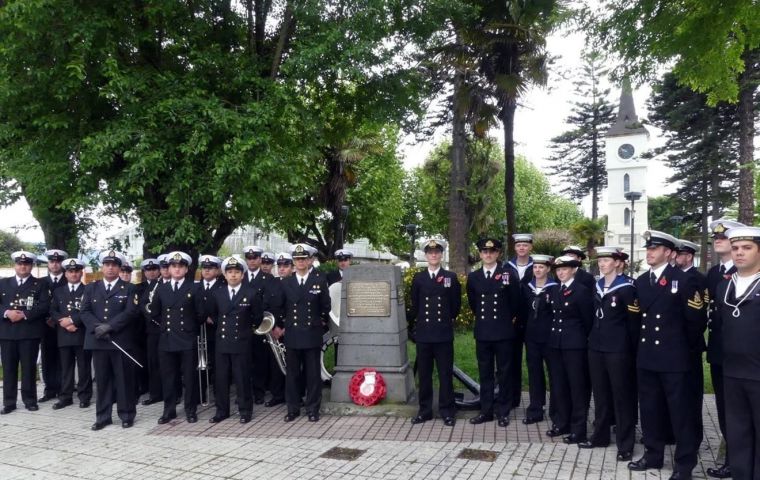MercoPress. South Atlantic News Agency
HMS Protector with Chilean navy paid homage to British losses at battle of Colonel, November 1914
 Chilean navy personnel and HMS Protector crew members at the Colonel battle memorial
Chilean navy personnel and HMS Protector crew members at the Colonel battle memorial Crew members Sailors from Ice Patrol HMS Protector, A173, and their Chilean allies paid homage to British sailors lost in one of the first great naval actions of World War 1. One hundred and ten years to the day that the Royal and German Navies clashed three dozen miles off the coast of Chile, the icebreaker ship’s crew joined Chilean sailors for a service of remembrance in the city which gave the battle its name: Coronel.
At last light on November first 1914 an outgunned and obsolescent Royal Navy squadron led by Rear Admiral Christopher Cradock attempted to bring an end to the escapades of German Admiral Graf von Spee and his East Asia Squadron.
The German ships had evaded all British attempts to intercept them for three months since abandoning their home base of Tsingtao – then a German colony – in China to prevent being trapped there when war broke out.
When Cradock’s squadron – two aged armored cruisers, one light cruiser and a passenger ship converted into an armed cruiser – sighted smoke on the afternoon of November 1 1914, the ships gave chase and soon found themselves facing Graf Spee’s force.
Despite being outnumbered and mostly outgunned, Cradock gave battle rather than regrouping to fight another day. His decision was in accordance with the “highest traditions of His Majesty’s Navy” – but it cost the lives of 1,660 officers and men.
A sailor aboard light cruiser HMS Glasgow, which suffered minor damage and escaped in the dark with the former liner-turned-warship Otranto, described the horrors aboard Cradock’s flagship HMS Good Hope and HMS Monmouth caused by von Spee’s guns:
“HMS Good Hope was hit all over and after the first ten minutes had many guns out of action – she was on fire forward and all along the port side …At 19:50 she blew up with a tremendous explosion…After that she never fired another shot and the enemy stopped firing on her also. There could have been practically nobody left alive aboard…
”The Monmouth had been frightfully knocked about early in the action too. Her fore turret took fire and she never got it out. She also was on fire all along her port side …There was a big head sea and half a gale too. She ceased firing when the Good Hope blew up…
“I had a lot of friends in the Monmouth. I fear none are saved…The blowing up of the Good Hope was an awful sight. I shall never forget it till I die.”
It was extremely important to remember this battle which took place on the far side of the world. It was an honor to be there, some 20 nautical miles from the spot in waters rarely frequented by the Royal Navy, Lieutenant Commander Phil Boak
A memorial plaque honors armored cruiser HMS Monmouth lost in the battle
Both ships sank with the loss of all hands. The Germans suffered just three wounded in a clash which lasted no more than three hours.
The Britons are commemorated by a memorial and plaques in Coronel – the focal point for sailors from HMS Protector, crew of the Chilean warship CNS Capitán Prat and the band of Talcahuano Naval Base honored Cradock and his men.
In the autumn of 1914, with Britain adjusting to the prospect of a lengthy war, defeat at Coronel was a blow to both national morale and the Royal Navy’s standing.
Although it had suffered losses and setbacks, notably the sinkings by German submarines in the opening weeks of the Great War, it had not lost a fleet action or battle with enemy surface forces in more than a century.
The shock provoked a disproportionate response from the British, who dispatched two capital ships – hitherto vital for keeping the bulk of the German High Seas Fleet in check in the waters of northern Europe – to hunt down Graf Spee’s squadron.
Six weeks later, on December 14 1914, that force – led by battle-cruisers Inflexible and Invincible – avenged Coronel by sinking most of the German ships off the Falklands.
As for 2024, HMS Protector until November she was undergoing routine maintenance in the Chilean Navy’s Talcahuano shipyard. She was back from an Arctic season research cruise and later joined recent exercises in the Pacific, the so called Unitas Chile 2024, during the month of September. They are exercises sponsored by the US Navy and in this case with the participation of 24 countries, with 19 vessels and 23 aircraft, among which HMS Protector and the Argentine ARA Sarandi. By now the Ice Patrol should be heading for the Antarctic summer campaign.




Top Comments
Disclaimer & comment rules-

Read all commentsJust for accuracy, Battle of the Falklands, when the Scharnhorst, Gneisenau, and other German ships were sunk, was on December 8th 1914 (not December 14th, as stated in the article above).
Nov 17th, 2024 - 10:01 am 0Commenting for this story is now closed.
If you have a Facebook account, become a fan and comment on our Facebook Page!